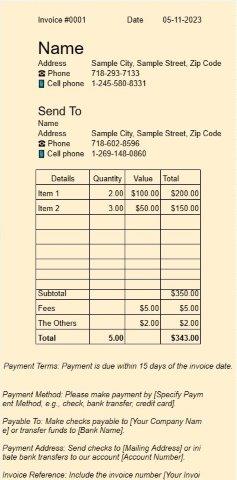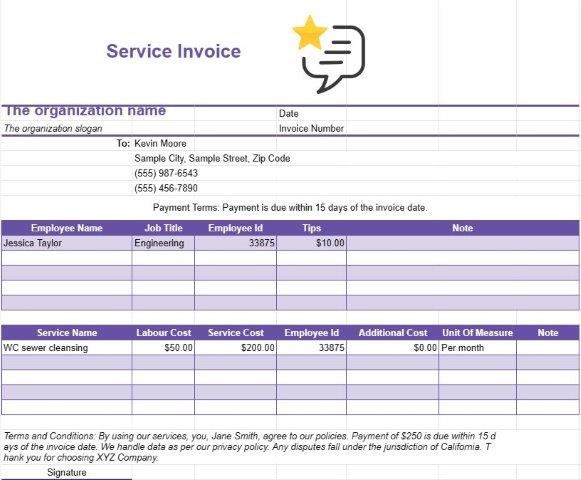

Bestelling
Categorie : Facturen
In de groothandel en fabriek gebruiken ze dit soort bestellingen formeel om de materiaalleveranciers te vragen de prijslijsten op te sturen.
Het inkoopordersjabloon is een fundamenteel document in de wereld van inkoop en supply chain management. Het dient als een officieel verzoek van een koper of organisatie aan een leverancier voor de aankoop van goederen of diensten. Deze sjabloon is zorgvuldig gestructureerd om cruciale details van de transactie weer te geven, inclusief artikelbeschrijvingen, hoeveelheden, prijzen, leveringsschema's, betalingsvoorwaarden en andere relevante voorwaarden.
In de kern fungeert de inkoopordersjabloon. als een juridisch bindend contract tussen de koper en de leverancier, waardoor de verplichting wordt versterkt om specifieke producten of diensten tegen overeengekomen voorwaarden te kopen. Laten we eens kijken naar de verschillende componenten en sleutelelementen die doorgaans in een inkoopordersjabloon voorkomen:
- Headerinformatie: De sjabloon begint met de koptekst, die doorgaans de inkooporder bevat. nummer, uitgiftedatum en contactgegevens van zowel de koper als de leverancier. Deze informatie is essentieel voor gemakkelijke identificatie en referentie.
- Koper- en leveranciersgegevens: Het inkoopordersjabloon specificeert duidelijk de wettelijke namen en adressen van beide partijen die bij de transactie betrokken zijn. Dit zorgt ervoor dat er geen onduidelijkheid bestaat over wie koopt en wie levert.
- Artikelbeschrijvingen: Een van de meest kritische secties van de sjabloon zijn de gedetailleerde itembeschrijvingen. Elk aan te schaffen artikel wordt afzonderlijk vermeld, samen met een duidelijke beschrijving, eenheidsprijs, hoeveelheid en totale kosten. Dit detailniveau laat geen ruimte voor misverstanden over de artikelen die worden besteld.
- Leveringsvoorwaarden: De sjabloon bevat voorwaarden met betrekking tot de levering van goederen, zoals de verwachte leverdatum, bezorglocatie en verzendinstructies. Deze voorwaarden zijn van essentieel belang om ervoor te zorgen dat de bestelde artikelen op tijd en op de juiste plaats aankomen.
- Betalingsvoorwaarden: De betalingsvoorwaarden worden uiteengezet in het Aankoopordersjabloon, waarin wordt aangegeven wanneer en hoe de betaling zal worden gedaan. Dit kan details omvatten over betalingsmethoden, vervaldata en eventuele toepasselijke kortingen of toeslagen voor te late betaling.
- Algemene voorwaarden: Om de belangen van beide partijen te beschermen, bevat de sjabloon vaak een sectie voor algemene voorwaarden. Dit kan betrekking hebben op zaken als garanties, retourzendingen, geschillen en boetes voor niet-naleving.
- Handtekeningen: Een aankooporder wordt doorgaans als een juridisch bindend document beschouwd als deze geautoriseerde handtekeningen van zowel de koper als de leverancier. Deze handtekeningen geven de formele aanvaarding van de algemene voorwaarden aan.
- Aanvullende opmerkingen: De sjabloon biedt vaak ruimte voor aanvullende opmerkingen of instructies. Dit kan worden gebruikt om specifieke vereisten of andere relevante informatie te communiceren.
Het inkoopordersjabloon speelt een centrale rol in het inkoopproces en biedt verschillende belangrijke voordelen:
- Duidelijkheid: Het biedt een duidelijk en gedetailleerd overzicht van de transactie, waardoor het risico op miscommunicatie of geschillen wordt verminderd.
- Juridische bescherming: Het dient als een juridisch bindend contract, dat de belangen van zowel de koper als de leverancier beschermt.
- Het bijhouden van gegevens: Inkooporders creëren een historisch overzicht van transacties, wat waardevol is voor boekhouding, auditing, en financiële analyse.
- Voorraadbeheer: Ze helpen bij het beheren van de voorraadniveaus door de aantallen te bestellen artikelen te specificeren.
- Budgetbeheer: Door artikelprijzen en totale kosten op te nemen, helpen inkooporders organisaties hun budgetten effectief te beheren.
Samenvattend is het inkoopordersjabloon een onmisbaar hulpmiddel in de inkoopwereld, dat ervoor zorgt dat dat transacties transparant, juridisch verantwoord en efficiënt beheerd zijn. Het speelt een cruciale rol bij het handhaven van een soepele bedrijfsvoering voor bedrijven van elke omvang en in alle sectoren.
Eenvoudig een spreadsheetsjabloon bekijken en downloaden
Bekijk de volledige versie van een spreadsheetsjabloon zonder beperkingen om te zien of u deze leuk vindt. Vervolgens kunt u de Excel-sjabloon downloaden om deze op uw apparaat op te slaan en gratis te gebruiken.
Krijg overal toegang tot de spreadsheetsjabloon
Dit werkt op alle populaire besturingssystemen zoals Windows, MacOS, Linux, iOS. U kunt de spreadsheetsjablonen bekijken en downloaden zonder extra programma's.
Hoe u een sjabloon gebruikt
Ontdek hoe u de spreadsheetsjabloon kunt bekijken, downloaden en vervolgens kunt gebruiken door de stappen te volgen die uiterst eenvoudig te volgen zijn
Meer vergelijkbare sjablonen
Bekijk meer spreadsheetsjablonen die onder dezelfde categorie vallen als de gekozen.






